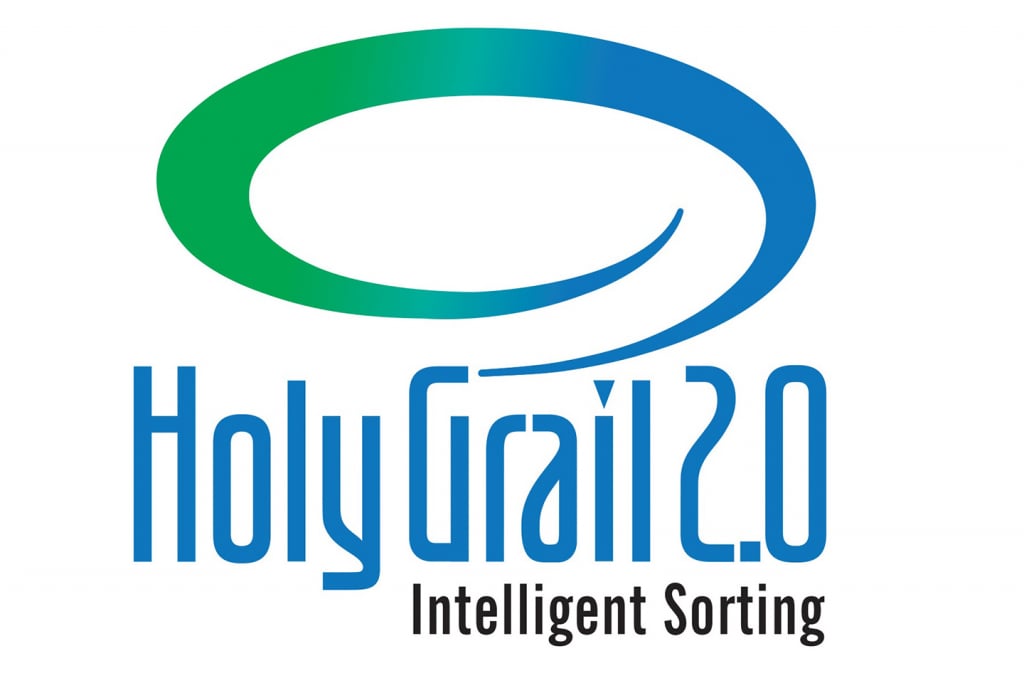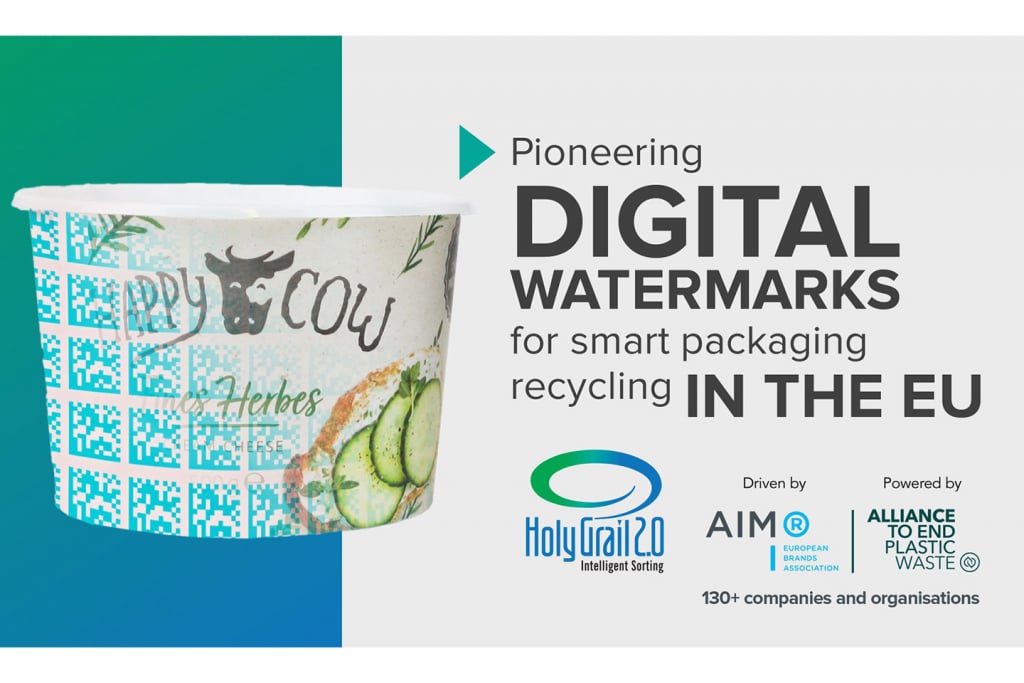Tag: circular
Groundbreaking sorting technology for packaging waste to be tested in Copenhagen
Dansk Retursystem is among the participants in HolyGrail2.0, which is an international collaboration with the European Brand Association, AIM towards a new cutting-edge technology for sorting packaging waste.

Presse
Artikel
6. september 2021
More than 130 companies and organisations throughout the packaging value chain across the EU have joined forces for a new ground-breaking solution. HolyGrail 2.0. deploys digital watermarks to ensure better sorting and higher quality in the recycling of packaging waste. The ambitions of the partnership are sky high.
HolyGrail2.0 has the potential t revolutionise the way we sort packaging waste
The project is led by European Brand Association, AIM with financial support from Alliance to End Plastic Waste, (AEPW). The solution is based on a potentially revolutionary technology employing digital watermarks that can contain detailed information about the product they are applied to.
Some of the participating companies in the project, including Arla, Coop, Danone, Nestlé, Orkla, PepsiCo, Procter & Gamble and Schulstad, will soon implement digital watermarks on selected products. The sorting solution is to be tested during autumn 2021 at the City of Copenhagen’s test facility at ARC – Amager Resource Centre. Here, a “semi-industrial” test will be carried out over a period of 3 months before the final tested solution in 2022 is demonstrated at full-scale in sorting plants in Germany and France.
The technology can contribute positively to extending producer responsibility
The trade association for Danish brand suppliers, MLDK, which is part of the partnership, is very excited about the prospects of the project in relation to the extended producer responsibility, which is soon to be implemented:
“We are happy and proud to help, test and promote digital watermarks in the HolyGrail project together with our Danish and international members,” says Niels Jensen, Director of MLDK. “We see great value in working with the grocery trade, the City of Copenhagen and a number of other players, as it shows that we share the goal of ensuring that used packaging does not end up as waste, but as a resource for new products. The project can also contribute positively to the future producer responsibility for packaging imported into Denmark from 1 January 2025.”
Revolutionising waste management
Digital watermarks are invisible to the naked eye and can therefore be printed all over the product packaging. This allows for a much more detailed automatic sorting of products during the waste phase than has so far been possible.
“HolyGrail 2.0 has the potential to revolutionise the way we sort packaging waste”, says Merete Kristoffersen, Head of Unit in Waste and Resources, City of Copenhagen. “We can sort food contact approved packaging, monolayer packaging and other specific product types. This will lead to much higher quality secondary raw materials and be an important step towards reusing food packaging for new food packaging, which is a cornerstone of Copenhagen Municipality’s plans for plastic recycling.”
Dansk Retursystem is also part of the project, and Market Director Marlene Holmgaard Fris says: “We certainly look forward to contributing to the collaboration and to the new test centre in Copenhagen. Together with the citizens of Denmark, we have created an effective platform that allows consumers to dispose of bottles and cans in a simple and responsible way and have them recycled in a closed loop for new packaging. We continue to pursue our goal of 99% recycling. That is why innovation, and the use of new technology are important elements for us – and a natural next step in the development of a circular economy, of which Dansk Retursystem is already a textbook example.”
For further information, please contact:
Anne-Mette Bundgaard Sørensen, Head of Communications and Branding, Dansk Retursystem,
amb@danskretursystem.dk Tel. +45 4332 3410
To the End of Life
The HolyGrail2.0 project introduces a new cutting-edge technology for sorting packaging waste in the future. The project was tested in autumn 2021 at ARC (Amager Resource Centre) in Copenhagen.
Our contribution to the project, the film, “To the End of Life”, shows the perspectives of a technology that may provide a future solution to recycling increasing volumes of packaging waste – if we invest and work together across industries and borders.
Digital watermark of the future
In Denmark we have one of the world’s best deposit systems, where as much as 93% of all empty bottles and cans with a deposit label are returned and turned into new ones. However, if we are to include the remaining 7%, the Holy Grail – in the shape of a digital watermark on all packaging – can be the lever to channelling some of the bottles and cans that would otherwise end up in the waste streams into a closed loop where they are recycled in a ‘bottle-to-bottle loop’.
Behind the project HolyGrail 2.0 are a group of companies, including Dansk Retursystem, and the European Brands Association, AIM. Together, we are testing a digital watermark that has the potential to revolutionise the way we sort packaging waste.

What is a digital watermark?
Digital watermarks are the size of stamps and are spread across the surface of the packaging in a dense pattern. The watermark code can contain a wide range of information about the packaging’s different characteristics, such as material, whether the packaging is food contact approved, and whether it can be recycled. The watermark is printed or embossed on the packaging and is invisible to the naked eye but can be easily identified by the camera on a regular smartphone or by a scanner in a sorting plant. This results in a much more detailed automatic sorting of the packaging in the waste stream than has so far been possible.
Far too much plastic waste and packaging ends up in incinerators and in nature.
EU directive on extended producer responsibility for packaging
Not all EU countries have a producer responsibility system for beverage packaging like the Danish deposit and return system – or for any other packaging types, for that matter. As a result, far too much plastic waste and packaging ends up in incinerators or in nature. It is a waste of resources and a threat to our climate and the environment. That is why the EU wants to ensure that much more packaging is collected and recycled.
In 2025, an “Extended Producer Responsibility for Packaging” will be introduced as a result of an EU directive. This means that packaging-consuming companies, including grocery manufacturers and grocery shops, will be responsible for ensuring that the packaging they bring to the market is collected and recycled. This will motivate manufacturers to reduce their material consumption and to design more circular packaging.
Partnership ensures bottle-to-bottle recycling for green PET beverage bottles

The closed loop for green beverage bottles will contribute positively to the quantities of R-PET material for beverages in EU
The Dutch recycler Morssinkhof-Rymoplast and the Danish deposit system Dansk Retursystem have taken their long-lasting collaboration to a new level by extending the existing bottle-to-bottle loop for clear and light blue bottles to include green PET beverage bottles in line with the principle of circular economy.
Due to an increasing demand for recycled PET-materials among the European beverage industry ‘bottle-to-bottle recycling’ is growing in the EU – especially for the clear and light blue beverage bottles, whereas colored PET bottles are still mainly recycled into non-food applications and therefore no longer available in the food packaging loop.
The demand for recycled PET-bottle (R-PET) grade is projected to continue to grow. Particularly because PET beverage bottles in average must contain 25 percent of recycled plastic in 2025 according to the single use plastic directive. The directive also states that 77 percent of the plastic beverage bottles sold on the European market must be separately collected and recycled.
For several years Dansk Retursystem has supplied Morssinkhof-Rymoplast with bales of high-quality PET-bottles from the Danish market to be recycled in a closed loop into new bottles.
“We continuously strive to strengthen our common goal of ensuring that as many of the collected bottles as possible find use in the production of new bottles for beverages. Morssinkhof-Rymoplast is therefore happy to announce that we now have managed to establish a bottle-to-bottle loop for not only the clear bottles but also for all the green bottles that we receive and recycle from the Danish market”, CEO Stefan Morssinkhof says
The closed loop for green beverage bottles will contribute positively to the quantities of R-PET material for beverages in EU and to the possibility of meeting the obligations set out in the directive.
In Denmark all plastic beverage bottles for beers, soft drinks, mineral water, juice, iced tea, and alcoholic soft drinks are covered by the national deposit system operated by Dansk Retursystem that last year achieved a historical high return rate.
“92 percent of plastic bottles with deposit were returned by the Danish consumers in 2024. The vast majority were clear and slightly light blue PET-bottles, while the green PET bottles dominated the share of colored bottles. Since we work hard to achieve bottle to bottle recycling for as many items as possible, we really appreciate our joint effort in this field”, says Vice president and Director of circular economy at Dansk Retursystem Heidi Schütt Larsen.
Next step in the collaboration between the two companies is to ensure bottle-to-bottle recycling for the dark blue bottles.
For further information please contact Hanne Svenningsen, hsv@dansk-retursystem.dk


